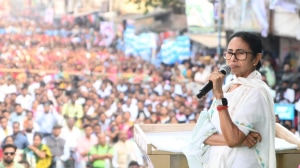“The year was 1947, and my grandfather had just migrated from Comilla, Bangladesh. Stepping off the train at Sealdah Station in Calcutta, he was greeted by a sight that was both amusing and bewildering: trams, those whimsical metal carriages, gliding gracefully along the roads. He couldn’t help but wonder what kind of city ran its trains in the middle of the street,” recounts Sagnik Gupta, cinematographer and Joint Secretary of the Calcutta Tram Users Association (CTUA), a citizens’ forum established in December 2016 to advocate for the preservation of trams.
“Little did he know,” Gupta continued, “that this was no ordinary railway; it was an electric tram. With no buses in sight, these trams would become his daily companions as he forged a new life in a new nation.”
Although trams have gradually faded from the cityscape, the West Bengal government’s recent decision to further reduce Calcutta’s cherished tram network has led to anger and sorrow among residents. The matter is now pending in the High Court.
The origins
The introduction of trams in colonial Calcutta was part of a broader British initiative to urbanise and improve the city’s infrastructure. In 1803, Governor-General of Bengal Lord Wellesley’s Minute (document) on Town Development sought to enhance public health and infrastructure through urban planning, with a focus on clearing bazaars, ghats, and burial grounds. The 1857 Mutiny, which shifted control from the East India Company to the British Crown, further accelerated this transformation. Academic Ranjit Sen highlights this shift in his work Calcutta in Colonial Transition, stating, “From the 1850s, all avenues of investment were filled by British capital. From jute to railways, from tramways to steamship and electricity, the British capital was in command.”
With open drains covered and roadways improved, Calcutta was ready for its first horse-drawn tram in February 1873. Building on this progress, Sen notes that the British established the Calcutta Tramways Company (CTC) as a joint-stock company in London in 1880.
The inaugural trams rolled out from Sealdah, traversing Bowbazar, Lalbazar, Dalhousie Square, and Hare Street, marking the start of a new era in transportation. The Kalighat tram depot, Asia’s oldest, was established the following year in 1881. By 1884, Calcutta boasted a network of eight tram lines, including routes like Chitpore and Chowringhee.
 Horse-drawn trams of Calcutta (Source: Calcutta Tram Users Association Archives)
Horse-drawn trams of Calcutta (Source: Calcutta Tram Users Association Archives)
Between 1881 and 1900, horse-drawn trams gradually transitioned to steam-driven models. According to Sen, the electric supply from the Calcutta Electric Supply Corporation fueled further enthusiasm, prompting the CTC to introduce electric trams in 1902. Historian Sumit Sarkar, in his book Writing Social History, notes that these electric trams were among several “significant improvements” in the late 19th century, which also included underground gas lights, early telephones, motor cars, and electric lights and fans in select homes.
Story continues below this ad
Interestingly, these developments were not limited to Calcutta alone; trams also emerged in other parts of India. In Delhi, trams began operating in March 1908, and by 1921, there were 24 trams connecting Old and New Delhi. Madras (now Chennai) introduced horse-drawn trams in 1877, followed by its first electric tram in 1895.
Sociologist Meera Kosambi, in Bombay in Transition: The Growth and Social Ecology of a Colonial City, argues that the Bombay Tramway Company Limited, established in 1873, introduced its first horse-drawn trams in 1874, and electric trams in 1907. By the 1920s, trams had become essential to urban infrastructure and mass transportation.
Historian David Arnold, in his article The Problem of Traffic: The Street Life of Modernity in Late-Colonial India, published by Cambridge University Press, highlights that by 1923, Bombay’s trams served nearly 102 million passengers, Calcutta’s trams accommodated 57 million, and Madras transported around 18.5 million residents.
Story continues below this ad
However, the surge in public transport led to traffic congestion in colonial cities. Arnold notes that rising motor accidents and traffic issues were attributed to several factors: speeding, overcrowded public transport, hazards from tram tracks, and poorly maintained roads. He observes that early 20th-century newspapers were “full of sensational accounts” of tragedies, including the infamous Chowringhee crash in June 1922, where two racing taxi drivers collided with a cyclist and a Tollygunge tram.
 19th Century, Calcutta (Source: Calcutta Tram Users Association Archives)
19th Century, Calcutta (Source: Calcutta Tram Users Association Archives)
Another notable historical account involves the crash that claimed the life of Bengali poet and writer Jibanananda Das, who is believed to have been struck by a tram near Deshapriya Park in South Kolkata. “He reportedly failed to notice the tram despite the driver sounding the bell. Some speculate it may have been an attempted suicide,” says Gupta. Tragically, he died four days later.
Despite these challenges, trams remained a popular mode of public transport well into the early 20th century.
Tramway workers: The unsung heroes
Over time, Calcutta tram workers became key figures in the city’s public and political life. They fought for fair wages and essential needs while actively engaging in broader political movements. As employees of a British-owned company, tram workers were viewed by Indians as both ‘black servants’ resisting white despotism and as Indians opposing British imperialism.
Story continues below this ad
In October 1920, the first union of Calcutta tramway workers, the Calcutta Tramways Employees Union (CTEU), was formed following a spontaneous strike that demanded better wages, drinking water, regulated duty hours, and latrines in the depots. This group was later renamed the Calcutta Tramways Workers’ Union (CTWU) in 1927. Their influence was so profound that a 1967 journal cited by Historian Siddhartha Guha Ray in his essay Protest and Politics: Story of Calcutta Tram Workers 1940–1947 remarked,“Hence, whenever a political movement takes place in the city, the Calcuttans look forward to the tramwaymen for their possible role in the event.”
Tramway workers consistently went above and beyond to serve the nation. In 1943, amid a devastating famine in rural Bengal, they organised shelter and food for millions fleeing Calcutta to escape hunger and disease.
Three years later, on August 16, 1946, the Muslim League declared ‘Direct Action Day’ to emphasise their demand for a separate Muslim homeland following the British departure from the Indian subcontinent. This declaration triggered widespread rioting in Calcutta, marked by mass killings and looting. On this day, tram workers from a nearby depot mobilised to protect a girls’ college under threat, standing vigilant until all the students were safely escorted out.
Story continues below this ad
Gupta shares a gripping story from a tram conductor about that chaotic day: “Amid the turmoil, Calcutta’s tram workers rescued injured individuals, both Hindus and Muslims, from the streets, providing them shelter at the Rajabazar and Kalighat depots, along with medical supplies for assistance.”
In March 1947, Calcutta was swept by yet another wave of Hindu-Muslim rioting. Despite the economic strain from months-long strike, tram workers demonstrated remarkable resilience against communalism, marching through the city with strike badges to help ease tensions. “People in general, especially men from poorer sections, developed an unflinching faith in the secular credentials of the Calcutta tramwaymen,” Ray observes.
Trams in Independent India
Post-independence, discussions about the future of tramways emerged. Purbasha Das, assistant professor at the Dhirubhai Ambani Institute of Information and Communication Technology in Gujarat, explains that “the nationalisation of public transport systems in India was an effort by the Indian government to streamline operations and regain control from private companies.” She notes that non-viability and operating losses in Delhi, Bombay, and Chennai led to the discontinuation of trams in these cities, as seen in Bombay’s closure of its nearly century-old tram network in 1964.
In contrast, Das believes trams persisted in Calcutta because they represented a romantic vision of the city, aligning with its slower pace and the residents’ preferences. “It was also very much about nostalgia,” she remarked. By 1967, the Government of West Bengal took control of the CTC, which was fully nationalised by 1978.
Story continues below this ad
Following this, interest in reviving tram service grew as awareness of air pollution and rising fossil fuel prices increased. “With a World Bank loan in the 1980s, 200 steel-body trams were introduced between 1983 and 1989, and they’re still in operation today alongside some fibre-body trams from the 2010s,” Gupta explains. In 2013, the West Bengal government enhanced the service further by introducing air-conditioned trams on select routes.
 Trams in Gariahat Depot (Express photo by Nikita Mohta)
Trams in Gariahat Depot (Express photo by Nikita Mohta)
Yet, the tram network has been on a decline over the past decade, and today, only two routes remain. Gupta attributes this trend to the dissolution of the CTC in 2016 and its merger with the West Bengal Transport Corporation (WBTC). Several reasons were cited for discontinuing tram services, including their slow speed, traffic congestion, narrow streets, and the necessity for flyovers and national highways.
The end of an era
For over a century and a half, these carriages have ferried generations of locals, becoming an indelible part of the city’s identity, but as the West Bengal government plans to phase out trams, dissent is growing.
IT professional and tram enthusiast Sounak Sengupta says that “blaming trams is misguided,” pointing out that they don’t contribute to reckless driving or overcrowding. “Why does Kolkata struggle to maintain its tram system while cities in Europe, Russia, and Taiwan have successfully kept theirs operational,” he asks.
Story continues below this ad
The plight of tram riders — often less affluent — highlights broader urban equity issues, raising the question of whether parked cars should take precedence over public transport. Urban mobility expert Shreya Gadepalli says that each tram carries over two hundred passengers while occupying minimal road space, unlike cars, which often hold just one or two occupants. “So who is really causing congestion?” she asks.
Advocates for restoring trams acknowledge challenges, such as tracks being in the middle of the road, but they fondly recall the days when trams had dedicated elevated grass tracks. “Even in 2024, trams remain the least polluting form of public transport, affordable for the poor and accessible for the elderly and differently abled,” says Sanghamitra Dasgupta, a former teacher at Shri Shikshayatan School in Kolkata. Having spent her early childhood living near Deshapriya Park, she was a frequent tram user. Dasgupta also highlights the sustainability potential of trams, suggesting that harnessing solar and wind energy could make them self-sufficient.
 Trams on elevated grass tracks (Source: Calcutta Tram Users Association Archives)
Trams on elevated grass tracks (Source: Calcutta Tram Users Association Archives)
As the roar of speeding metros drowns out the melodic clatter of tram wheels in the West Bengal capital, conductors and drivers at the Gariahat Tram Depot carry on with their daily routines. In conversation with Indianexpress.com, they fondly recall a time when tourists, both local and international, eagerly awaited trams, spending hours gazing out from behind the grilled windows, soaking in the city’s vibrant atmosphere amid the lively chatter of fellow passengers. They reminisce about the days when filmmakers from around the world flocked to Calcutta to capture the charm of its iconic trams. Yet, a shadow loomed over their nostalgia: concern for the city’s students who frequented College Street, for the sick and disabled visiting the government hospitals, and the economically less fortunate inhabitants who saved on bus fare by using trams; trams that guided everyone to their final destination.
For some, the vanishing trams symbolised the erasure of Calcutta’s unique identity; for others, it represented the end of a cherished family legacy. “My father served the trams from 1964 to 1984, and I took it over from there” said Gavin Rozario, the last Anglo-Indian conductor of Calcutta’s tram service. His voice trembled with emotion as he continued, “When I joined 40 years ago, there were 400 trams and 55 routes. Now, as I prepare to retire on October 31, only 2 routes remain — Gariahat to Esplanade and Esplanade to Shyambazar — with just 10 to 12 trams limping along. As I bid farewell, I fear I’m not just retiring, I’m witnessing the end of an era.”
Story continues below this ad
Suddenly, a fellow conductor interjected, urgency in his voice, “Gavin! Speak in a way that makes them listen, that ensures the trams stay.”
Further Readings:
-
Calcutta in Colonial Transition by Ranjit Sen
-
Writing Social History by Sumit Sarkar
-
The Problem of Traffic: The Street Life of Modernity in Late-Colonial India by David Arnold
-
Bombay in Transition: The Growth and Social Ecology of a Colonial City, 1880-1980 by Meera Kosambi
-
Protest and Politics: Story of Calcutta Tram Workers 1940–1947 by Siddhartha Guha Ray



 Horse-drawn trams of Calcutta (Source: Calcutta Tram Users Association Archives)
Horse-drawn trams of Calcutta (Source: Calcutta Tram Users Association Archives) 19th Century, Calcutta (Source: Calcutta Tram Users Association Archives)
19th Century, Calcutta (Source: Calcutta Tram Users Association Archives) Trams in Gariahat Depot (Express photo by Nikita Mohta)
Trams in Gariahat Depot (Express photo by Nikita Mohta) Trams on elevated grass tracks (Source: Calcutta Tram Users Association Archives)
Trams on elevated grass tracks (Source: Calcutta Tram Users Association Archives)





























